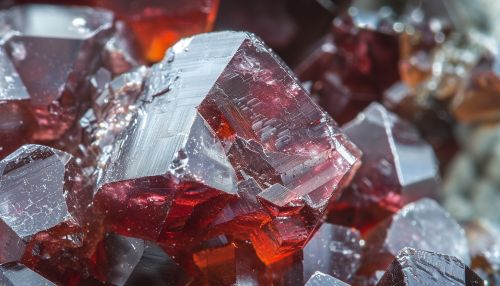Garnet
Introduction
Garnet is a group of silicate minerals that have been used since the Bronze Age as gemstones and abrasives. All species of garnets possess similar physical properties and crystal forms, but differ in chemical composition. The different species are pyrope, almandine, spessartine, grossular (varieties of which are hessonite or cinnamon-stone and tsavorite), uvarovite and andradite. The garnets make up two solid solution series: pyrope-almandine-spessartine and uvarovite-grossular-andradite.
Physical properties and crystal forms
Garnets are nesosilicates having the general formula X3Y2(SiO4)3. The X site is usually occupied by divalent cations (Ca, Mg, Fe, Mn)2+ and the Y site by trivalent cations (Al, Fe, Cr)3+ in an octahedral/tetrahedral framework with [SiO4]4− occupying the tetrahedra. Garnets are most often found in the dodecahedral crystal habit, but are also commonly found in the trapezohedron habit. They crystallize in the cubic system, having three axes that are all of equal length and perpendicular to each other. Garnets do not show cleavage, so when they fracture under stress, sharp irregular pieces are formed.


Chemical composition
Because the chemical composition of garnet varies, there are many different garnet minerals. The two main types of garnet, pyrope-almandine-spessartine and uvarovite-grossular-andradite, form two solid solution series. In these series, the garnet's chemical composition gradually changes from one end member of the series to the other. For example, in the pyrope-almandine-spessartine series, the chemical composition gradually changes from pyrope (Mg3Al2(SiO4)3), to almandine (Fe3Al2(SiO4)3), to spessartine (Mn3Al2(SiO4)3). The same gradual change in chemical composition occurs in the uvarovite-grossular-andradite series.
Geological occurrence
Garnets are found in a wide variety of rock types including metamorphic, igneous, and sedimentary rocks. A primary condition for garnet formation is the presence of high-pressure conditions, which are typically associated with the metamorphism of pelitic (clay-rich) rocks. Garnets can also form in igneous rocks as small crystals or as large, well-formed crystals in pegmatites. In sedimentary rocks, garnets are usually found in heavy mineral sand deposits, including those containing industrial garnet.
Uses of garnet
Garnets have been used in various ways throughout history. Due to their hardness, they have been used as abrasives for thousands of years. They are also used in water filtration, in a process called water jet cutting, and in abrasive blasting. In addition, garnets are commonly used as gemstones in jewelry. The different types of garnet have different properties, making some types more suitable for certain uses than others. For example, almandine garnet is commonly used as an abrasive, while pyrope and grossular garnet are commonly used as gemstones.
